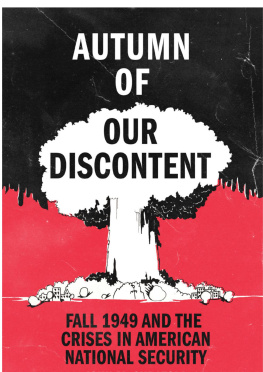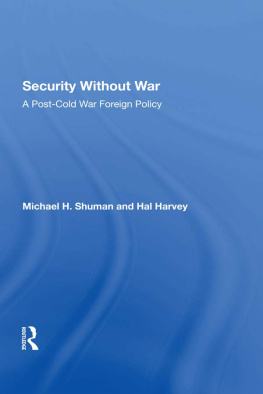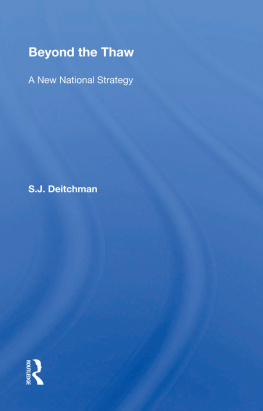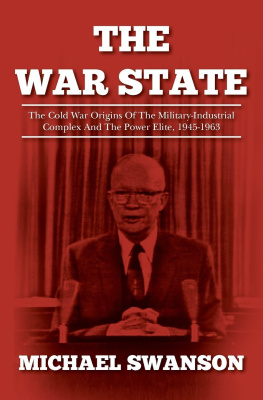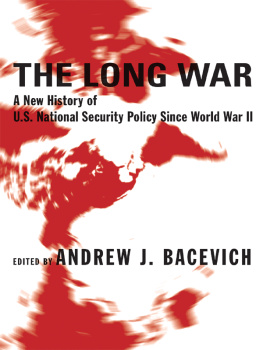Curatolas richly researched and fascinating study maps the confluence of the Soviet atomic bomb, the rise of Communist China, and the internecine Air ForceNavy squabbles in fall 1949. This Clausewitzian paradoxical trinity cast the die for the development of NSC 68 and an unprecedented shift in American national defense policy.
Frank A. Blazich Jr., military history curator, Smithsonian National Museum of American History
Curatola weaves an exciting and powerful narrative that brings a new perspective to a key turning point in American history. This reexamination of how U.S. defense strategy dramatically changed in the early Cold War is extremely relevant to present-day defense and foreign policy debates.
Michael W. Hankins, curator, Smithsonian National Air and Space Museum, and author of Flying Camelot: The F-15, the F-16, and the Weaponization of Fighter Pilot Nostalgia
We tend to look back at seminal history with a belief that the course of events was as obvious to those who lived them as they are to those who read about them in hindsight. In reality, nothing could be further from the truth; it is of this misnomer that John Curatola most directly dispossesses us. For what may seem obvious to those who lived through the end of the Cold War was far from a settled question in the critical year of 1949. With the Cold War just getting underway in the autumn of 1949, the events of that period have often become lost, forgotten, or taken for granted. It is against this backdrop that Curatola demonstrates the anything-but-settled questions over what the Cold War would be, how it would be fought, and who would win. The authors excellent research combined with insightful analysis leave little doubt as to the fact that the fall of 1949 was a turning point in the course of the Cold War.
Trevor Albertson, author of Winning Armageddon: Curtis LeMay and Strategic Air Command, 19481957
AUTUMN
OF
OUR
DISCONTENT
FALL 1949 AND THE
CRISES IN AMERICAN
NATIONAL SECURITY
JOHN M. CURATOLA
Naval Institute Press
Annapolis, Maryland
This book has been brought to publication with the generous assistance of Edward S. and Joyce I. Miller.
Naval Institute Press
291 Wood Road
Annapolis, MD 21402
2022 by The U.S. Naval Institute
All rights reserved. No part of this book may be reproduced or utilized in any form or by any means, electronic or mechanical, including photocopying and recording, or by any information storage and retrieval system, without permission in writing from the publisher.
Library of Congress Cataloging-in-Publication Data
Names: Curatola, John M., [date] author.
Title: Autumn of our discontent : fall 1949 and the crises in American national security / John M. Curatola.
Description: Annapolis, Maryland : Naval Institute Press, [2022] | Includes bibliographical references and index.
Identifiers: LCCN 2021061120 (print) | LCCN 2021061121 (ebook) | ISBN 9781682476208 (hardcover) | ISBN 9781682476215 (ebook)
Subjects: LCSH: National securityUnited StatesHistory20th century. | Cold War. | Nineteen forty-nine, A.D. | United StatesForeign relations1945-1953. | United StatesPolitics and government1945-1953. | United StatesMilitary policyHistory20th century. | BISAC: HISTORY / Military / Wars & Conflicts (Other)
Classification: LCC E813 .C87 2022 (print) | LCC E813 (ebook) | DDC 355/.033073dc23/eng/20220201
LC record available at https://lccn.loc.gov/2021061120
LC ebook record available at https://lccn.loc.gov/2021061121
Print editions meet the requirements of ANSI/NISO z39.48-1992 (Permanence of Paper).
Printed in the United States of America.
30 29 28 27 26 25 24 23 22 9 8 7 6 5 4 3 2 1
First printing
For Clara Jane, who endured, persisted, and loved.
Contents
Acknowledgments
This book is the result of four years of research and writing. Much of the text reflects the brutal, yet exceptional, editing skills of Dr. Janet Valentine. She spent many hours correcting my prose and syntax while surrounded by four cats clamoring for her attention. Her keen eye was an invaluable asset, making this a much better work and contribution to the field of history. Additionally, Drs. Rick Herrera and Tony Carlson were constant sources of encouragement, trusted colleagues, and fellow travelers. They helped me pursue a higher standard of scholarship, and I value their friendship and camaraderie. The archivists at the Truman and Hoover Presidential Libraries, the U.S. Naval History and Heritage Command, and the Library of Congresss Manuscripts Division were key in helping me locate the relevant documents. Furthermore the leadership of the U.S. Army School of Advanced Military Studies at Fort Leavenworth, Kansas, provided the time and resources for this endeavor. This is especially true of Dr. Scott Gorman and Ms. Candy Hamm, who were supportive at every turn to make this book a reality. I could not have written this work without their help. Finally, my gratitude to Adam Kane, who, despite a trying first year as the Naval Institute Press director, helped shepherd this work to publication.
INTRODUCTION
First Lieutenant Robert Johnson and the airmen assigned to crew 5A were having a frustrating day. Serving in the U.S. Air Forces 375th Weather Reconnaissance Squadron (WRS) on 30 August 1949, the men were scheduled to fly out of Yokota Air Base, Japan, just outside of Tokyo, to their home station of Eielson Air Force Base, Alaska. As they started the engines on their WB-29 aircraft, a modified version of the four-engine B-29 Superfortress bomber, one of the four R-3350 power plants sputtered, coughed, and quit before takeoff. Determined to fulfill their mission, the crew took command of an alert standby aircraft. Simultaneously, a typhoon, common during this time of year around Japan, was bearing down on Yokota. With winds increasing and skies darkening, the crew hoped to beat the bad weather. While Lieutenant Johnson and his crew got airborne before the storm hit the airbase, their bad luck continued.
About an hour into their flight, while over the island of Honshu, the number-three engine, adjacent to the copilots side, began spewing smoke. The rhythm and hum of the engine was interrupted by the disturbing vibration of mechanical failure. Instruments for the power plant fell out of their normal operating ranges, with fire-warning lights aglow. With this dire emergency, Johnson immediately called for engine shutdown. Both he and the flight engineer immediately initiated emergency procedures and engaged the engines fire-extinguisher system. With these actions the crew hoped to avoid having the flames burn through the firewall and into the wing, where they could ignite the fuel cells. The only thing they could do now was hope the fire had not spread.
Fortunately for the crew, the emergency procedures worked and the flames extinguished. But with only three fully operating engines, the plane was still in danger. If it lost another engine, the WB-29 would be unable to maintain level flight. Under the circumstances, Johnson could not risk the long, dangerous journey over the northern Pacific Ocean. While bailing out from or ditching an aircraft was dangerous enough, doing so over those waters meant almost certain death, with hypothermia setting in after only a few minutes. Additionally, given the large expanse of the northern Pacific combined with the fickle nature of the regions weather, the crewmen would have very little chance of being rescued. Lastly, given the political situation of the emerging Cold War, making an emergency landing somewhere in the nearby Soviet Union was definitely not an option.
With the three other heavily laden engines now operating at full tilt, and Johnson seeking a return to Yokota, his frustration mounted as the typhoon moved in over Yokota. Hoping for landing assistance, he radioed Ground Control Approach to receive specific landing instructions from an air-traffic controller on the ground. Looking at a radar screen and knowing exactly where the WB-29 was in relation to the runway, the controller would help guide the pilot to a specified point at which the runway would appear once the plane descended below the clouds. Yet adding to the pilots string of bad luck that day, the bases radar failed, rendering it useless to both the controller and the pilot. Johnson had to make a quick decision.
Next page
